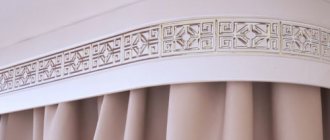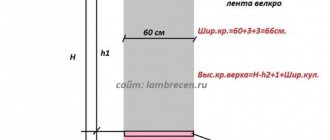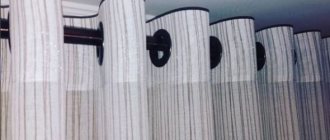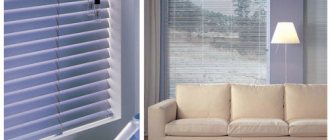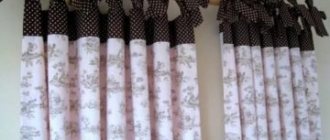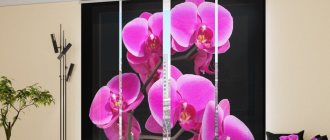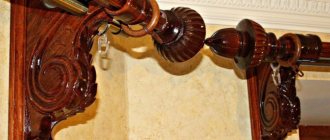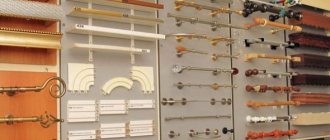The classic design of a window opening will require hanging a cornice - a structure consisting of 2 or more brackets, a crossbar or rod and tips. Using rings, clothespins, ties and other devices, curtains and (or) curtains are hung on the base. The decorative system is selected to match the interior design of each room in the house. But even a carefully chosen style and color does not guarantee that it will fit neatly into the space. It will complement it, decorate it. To ensure the perfect look of the window, you need not only to choose curtains wisely, but also to hang the curtain rod correctly on the wall or ceiling. Knowing a few secrets, it won’t be difficult to do it yourself.
Which cornice is better: ceiling or wall
The main advantage of a ceiling cornice is the ability to use long curtains, from the ceiling surface itself, to decorate a window. Thanks to this, it is possible to visually make the room much higher than it actually is. By using the ceiling version of the cornice in rooms with low ceilings, you can completely solve the problem of a small space.
In addition, ceiling structures can be used almost everywhere, in niches too. Most often, a string cornice is installed in rooms, consisting of two support brackets and metal strings stretched between them. Its advantage is its low cost and ease of installation. The only disadvantage of such a ceiling cornice is the sagging of the strings, which require periodic tightening. It is only permissible to hang curtains made of lightweight material on it; it will not withstand heavy loads. Ceiling structures are especially relevant for decorating windows of non-standard shape.
If there is no need to increase the height of the room, then a wall-mounted cornice would be an acceptable option. Its undeniable advantage is its huge assortment, where you can choose a design in country, retro or classic style. So, for rooms in a classic style with wooden panels, a wooden wall cornice would be a good solution. But metal fixtures with decorative elements such as forged parts and curlicues are best used for modern or avant-garde interiors. Plastic cornice is a universal design that fits perfectly into the design of any room.
When selecting a cornice, it is important to consider the size of the room, especially the height. You need to try to find an option that will most effectively emphasize all its best sides, and mask its disadvantages.
If the ceiling is plasterboard
If it was decided to install a ceiling cornice at the renovation stage, most likely there is a special niche in which it is installed. In this case, it is attached to the ceiling, and how to attach the ceiling cornice to concrete and wooden floors is described above. It will be a little more difficult, since freedom of action is limited, but not critical.
Attaching the cornice in a niche is a little more inconvenient
There may be a second option - without a niche. A wooden beam is fixed at the place where the cornice is installed. It is located between the drywall and the main floor. In this case, the ceiling cornice is attached to the beam through plasterboard. You need to use wood screws of sufficient length so that the body of the beam contains at least 2/3 of the length (preferably more).
But if you decide to replace the cornice with a ceiling one after the repair, you will have to look for special fasteners. These are the so-called butterfly and snail dowels. Both are characterized by an increased contact area with the material, due to which the load is distributed over a larger surface. But it’s still better not to use heavy fabrics.
Using special fasteners for drywall
Both types of drywall fasteners - butterfly dowel and snail dowel - come in plastic and metal. Stronger, obviously metal. But the trick is that most likely it is not the dowel that will withstand the high load, but the drywall. To prevent this from happening, reduce the fastener installation step. For example, you can make it 40-45 cm. This will increase labor intensity, but will give at least some hope that the structure will not collapse.
How to choose wall curtain rods
The determining factors for choosing a wall cornice are:
- Load. The structure must support the weight of the curtains. You should not use massive structures for light curtains (veils, organza), and vice versa. There must be a golden mean in everything.
- Curtain fastenings. They should be selected taking into account the material; when using them there should be no obstacles, unpleasant sounds, or “stuckness”.
- Mounting type. When using lightweight fabric, both ceiling and wall options are suitable. But for heavy curtains, it is optimal to use a ceiling mount.
- Availability of radiators and heating systems. The curtain should hang freely; if there are batteries, then they should be taken into account when installing the curtain rod.
In addition, the following points must be taken into account:
- to decorate a narrow window, a long cornice looks more harmonious, where the curtains will cover part of the wall;
- For low ceilings, it is preferable to use structures with a ceiling type of fastening.
To decorate a very large window, you need to select structures that are similar in width.
Selecting wall brackets for curtain rods
There are several types of brackets - holders. This structural element is attached to the wall; it must be made of the same material as the cornice itself. It is thanks to a good connection that the reliability of the entire mechanism is ensured. Holders available:
- L-shaped, which are attached to metal structures, they do not create difficulties during installation work or difficulties in determining the hole for fasteners;
- round in shape, collapsible - they are 1.5-4.5 cm in diameter, they are made from metal, plastic or wood, they are used for mounting both on the wall and on the ceiling surface;
- solid ones, which have holes for installing fasteners, they are more often used for wooden structures.
If we compare the degree of installation complexity among the above types of brackets, it is most difficult to work with round collapsible holders.
Installation of a ceiling cornice to a concrete floor
The procedure for attaching a ceiling cornice is not too complicated, but if the length of the product is more than two meters, an assistant will be required. In addition to the fasteners, you only need a drill and a screwdriver with a suitable slot.
Preparation
Before attaching the ceiling cornice, it is necessary to carry out some preparatory work. The first thing we do is adjust the length. If everything suits you, great. If you need to cut off excess, you will need a hacksaw. It is advisable to use a cloth for plastic, but it is also suitable for metal. If the cornice is assembled, remove the plugs and turns (if any), cut off the excess, then return everything to its place - the turn, the plug.
Adjusting the length
If the holes for the fasteners are not drilled at the factory, you will have to make them yourself. Let's start with the markings. Mark so that the distance between adjacent screws is no more than 50-60 cm. If there are joints, then retreat 5-10 cm from the joint on both sides. For better load distribution, it is better to stagger the mounting holes.
After the marks are set, we drill mounting holes in the plastic. Use a drill that is equal in diameter to the size of the fastener. More is undesirable, but less is also not good - when twisted, the plastic may crack.
Even for a single-row cornice, it is better to place the holes in a checkerboard pattern
After all the holes are ready, if the cornice is prefabricated, assemble all the parts. You don't have to install the decorative trim (if any). For now she will only get in the way.
How to attach
In most apartments and many private houses the ceiling is a concrete slab. Accordingly, we take a drill for concrete. The diameter of the drill should be taken according to the size of the dowel. Then we proceed according to plan:
- We apply the assembled cornice to the ceiling and level it.
- Use a simple pencil or marker to mark the attachment points.
- We drill holes, trying to hit exactly the marks. The depth is equal to the length of the plastic insert. To make control easier, you can stick a strip of electrical tape on the drill.
Already fixed, but without curtains
- We insert the plastic part of the dowel into the hole. It should be flush with the ceiling. The protruding parts will interfere with installation, so we either deepen the hole or cut off the excess plastic.
- After all the plastic parts of the dowels are installed, if the decorative strip is attached to the grooves (not with Velcro), install it. It is not always possible to “latch”, so you should not hope that you will install it “later”. Most often you have to put on this bar gradually, moving along the grooves as if on rails. This cannot be done on the ceiling; you have to remove the already mounted cornice. As you understand, this does not improve the mood.
- We attach the assembled cornice to the marks. First we install the fasteners along the edges and in the center. If the cornice is long, we fasten the two halves with an additional one or two dowels. So that the plastic does not sag. The following installation order is arbitrary.
That's all, actually. You know how to attach a ceiling cornice to a concrete floor. If the floor is wooden, everything is even simpler: there is no need to pre-install dowels. After all, wood screws are usually used. In this case, the cornice is leveled and screws are immediately placed in the mounting holes. It’s more convenient to follow the same order: along the edges and in the center, and then - as it turns out.
How to hang wall-mounted curtain rods
In order for the curtain to look impressive in the room, it is necessary to correctly install the wall structure.
Assembling a wall cornice
Depending on the model of the curtain rod being installed, the assembly process may vary. If it is a solid sheet of metal, then this step is skipped. There are modifications that can be equipped with brackets. To fix them, you need to tighten the bolts to form a solid structure. For example, a cornice in the form of a tire is a simplified version of this design.
Wall cornices: photos in the interior
There are many models of wall structures on the market, each of which is distinguished by its originality and reliability. To make the process of choosing a cornice easier, you can view photos of the most popular options.
How to hang curtain rods correctly
Hanging a curtain rod generally takes fifteen minutes, but this is only if a master is working. But if a person has never done this, difficulties may arise. There are two types of cornices of this format: wall and ceiling. There are almost no differences in installation, except that wall-mounted ones are hung on the wall, ceiling ones are hung on the ceiling.
After purchasing everything you need, the question arises: at what height can you hang the curtain rod? The height can be changed, but it is best to attach it so that it is as close to the ceiling as possible, then the curtains will look much more beautiful. The most optimal distance from the ceiling to the cornice is 5-10 cm. You must pay attention to how the curtains will be attached.
How much space do you need for curtains?
The standard extension of the cornice is 15-18 cm. Therefore, do not forget to leave at least 20-25 cm of free space from the wall for curtains. If you need to hang blackouts or special curtains on the windows that do not let in sunlight, then do not forget to add a third row of the cornice.
Interesting materials:
What is a cash register on a check? What is the FSS database code? How can I find out the OKATO territory code? What is college in the USA? Compensation for staff reduction for how many months? What is the consulate? Feeding small rabbits what and how to feed? Cortisol what? Creatine monohydrate how much to take? What is the origin of the Kuril Islands?
Which is better: cornices on the ceiling or on the walls?
When choosing a design, you need to consider not only the type of curtains, but also your personal taste. It is important to consider the place where it will be installed. The installation height of the cornice above the window should be taken into account taking into account the aesthetic component. In this case, ceiling products look nicer in appearance than wall products, and all because when mounted to the ceiling, the curtains completely cover the window opening and all the way to the floor. The good thing is that the ceiling cornice well hides the entire curtain fastening system, which cannot be said about the wall-mounted version.
At what distance from the wall to mount
The first question that arises when you start installing a cornice above a window is at what distance from the corner it should be attached. Close? Stepping back 10 cm? 20 cm?
The curtain rod should be placed so that it hangs freely without touching the window sill or heating radiators.
In fact, the distance can be from 8 to 15-20 cm. It is determined depending on the location of the heating radiators and/or window sill. The cornice must be placed so that the tulle and curtains hang freely, without touching either one or the other. Firstly, this way the drapery lies perfectly, secondly, it is better for the fabrics, and thirdly, there is better air circulation, which is important during the heating season.
Three options for mounting the cornice to the ceiling
At what height can you hang a curtain rod? There are three design solutions:
- option - this method will visually shorten the room and reduce the window. Typically, it is used to brightly decorate trim around windows. Decorative and rich windows should always be on show, which means hanging curtains at the borders of the window so that the architectural features of the window opening are visible.
- This option allows you to properly hang a curtain rod over a window in a traditional style without adding visual interest to the room. This type is the most popular and practical.
- Option - installing a cornice in this form will make the window visually larger and taller, creating a feeling of freshness and modernity. That’s right, the walls visually appear higher, making the room look larger. In small spaces this option works very well.
How to calculate the length of the cornice?
The cornice must be chosen such a length that completely open curtains open the entire window opening. Visually it will be like this: the width of the window opening needs to be increased by one meter, i.e. half a meter on each side for assembled curtains.
Are you wondering how to properly hang a curtain rod over a window? Then imagine that on average the length of the structure reaches two meters, then for installation you can use only two fasteners. If ideally the length is longer, then an additional bracket should be made in the middle.
The length and dimensions of the brackets should also be taken into account. Curtains should not lie on window sills or heating radiators, because they usually protrude far beyond the wall.
The distance of the cornice from the ceiling should take into account the fact that the fasteners are usually mounted in a reinforced concrete lintel above the window. There is a reinforcement cage inside it, which means that a drill should not get into this rod, because it will not be possible to drill the required size of the recess.
We have already found out the distance at which the cornice is attached from the ceiling; now it remains to determine how the cornices should be installed from the walls. Typically, the brackets are located no closer than 15-20 cm from the walls. In order for the cornice to hang evenly, an equal number of centimeters should be measured from the ceiling on both sides of the brackets. This can be done using a special horizontal level. Important: walls are not always level, so be sure to visually ensure that you don’t get into trouble.
How to properly install a ceiling cornice
The ceiling cornice kit, as a rule, includes all the necessary fasteners - dowels and screws. The cornice is fastened to the ceiling along the edges using brackets or ceiling fasteners. If the length of the ceiling cornice exceeds 2 m, then an additional bracket (ceiling fastener) must be installed in the middle. Increasing the number of fastening elements for the cornice is important when using several rows of curtains, with a large mass of curtains and the massiveness of the cornice itself
Marking and fastening the cornice
Before marking the ceiling for the cornice, you should make sure that it will not obstruct the opening of the window or door to the balcony. It should also be far enough away from the walls and window sill so that the curtains do not cling to flowers or heating radiators standing on it. It is recommended to mark the installation site in such a way that the curtains hanging on it are located at a distance of at least 40 mm relative to the window sill and radiators.
To attach the ceiling cornice with your own hands, you need to prepare the following tools:
- electric drill;
- hacksaw;
- roulette;
- screwdrivers;
- building level;
- ruler;
- pencil;
- screws and dowels.
The dowels and screws that will be used when installing the ceiling cornice must match the material from which the ceiling is constructed. If the ceiling is made of plasterboard, then you need to attach it to the guides. Drywall will not support the weight of the cornice.
First, you should mark the places where the brackets are attached to the wall or ceiling mounts.
After marking is completed, holes for the dowels are drilled at the fastening points using a hammer drill and the dowels are driven into them. Next, depending on the installation method, either brackets for the cornices are mounted, or the cornice is placed against the ceiling and screwed directly to the surface. If its length is more than 200 cm, then the cornice must be additionally fixed in the middle so that it does not bend under its own weight and the weight of the curtains.
Hanging curtains on the cornice
You can attach curtains to the ceiling cornice using the following fasteners:
- Hooks and rings. They can come complete with a cornice or separately. In this case, hooks can be used as independent fasteners or in conjunction with rings. The use of this method of attaching curtains requires the presence of loops in them that will be put on hooks. This mount is great for light curtains.
- "Crocodiles." According to the principle of their operation, they are similar to ordinary clothespins, only because they have teeth, the fixation of curtains is more reliable.
- Kulisok. During the manufacture of curtains, a special pocket is sewn into which the cornice is inserted. This creates the effect of its absence.
- Clip. According to the principle of fastening, clips are similar to “crocodiles”, only they do not have teeth, so it is better to hang light curtains and tulle on them.
- Eyelets. Such fasteners are metal rings that are inserted directly into the curtains. With their help you can easily gather fabric into folds. Grommets can only be used with tubular curtain rods.
- Fabric loops. This fastener has a beautiful and natural look and goes well with round cornices.
To achieve folds on the curtains, it is necessary to attach the rings at the same distance, equal to approximately 100 mm. If they are mounted on clamps, they can be alternated with round rings. This will help create a better mount.
To create many small folds evenly spaced along the entire length of the curtain, there are special tapes. This method is most often used for constantly drawn light curtains. The ribbons are sewn along the top edge and pulled to the desired length.
When hanging curtains, a very important parameter is the distance from the floor to the curtains, because this value plays a decisive role in shaping the style of the entire interior of the room. The most common option is curtains, the ends of which are at a certain distance from the floor. In most cases, this distance is about 3-6 cm. When sewing, you need to know exactly their length. The slightest error will lead to the fact that the processed edges will have to be embroidered and remade.
For the kitchen and nursery, we recommend short curtains that barely cover the window sill, or arched ones. But in rooms with low ceilings, this option will not look the best, because it will visually lower the room even more.
By choosing a suitable ceiling cornice, beautiful curtains and fastenings for them, you can create a magnificent visual effect that can transform your room, making it stylish and elegant.
The process of attaching the cornice
You can also secure the curtain rod with your own hands. First, you need to drill out the required socket for the bracket using a hammer drill. A dowel is initially inserted into it; it should not protrude beyond the plane of the wall. Next, you need to attach a special fastening element and secure it with screws, wrapping them in a plastic dowel.
After the supporting elements are secured, you should begin installing the cornice, according to the instructions for the cornice.
When all the walls are painted and the furniture is in place, the only thing left to do in the apartment is to hang the curtains and enjoy the warm stay inside. But in order for expensive tulle with curtains to show off in the right place, you need to know how to properly hang curtain rods in relation to the window. There is nothing difficult here, but some nuances are still present. Read our review and learn all the features of installing curtains.
The cornice is an indispensable element of the interior, without which it is impossible to hang curtains
Installation on a suspended ceiling
In the case of a suspended ceiling, the ceiling cornice can only be secured to a pre-installed embedded beam. It is secured before the fabric is stretched. When fastening, use wood screws and attach them directly to the beam through the ceiling sheet.
How to attach a ceiling cornice to a suspended ceiling
The second option is a niche for installing a cornice, but this is also made during the installation of the ceiling and not later. In this case, there is also a wooden beam, but a guide for the stretch ceiling is attached to it.
Attaching a ceiling cornice in a stretch ceiling niche
There are no options for installation on a ready-made stretch ceiling. There is, however, a compromise - mounting to the wall with brackets right under the ceiling. There is a gap to the ceiling, but it is small and not too noticeable.
Types of cornices
For each special room design, construction stores always have several different types of cornices in stock. They differ in:
- type of material of manufacture;
- method of fastening and type of fastener;
- the shape of the supporting beam.
When choosing a cornice, it is important to take into account the style and weight of the curtains, the shape of the window and the style of the room.
Wood, metal and plastic are used as materials for making fastenings for window textiles. Each material is successfully used for various interior styles. Plastic products are especially popular due to their low cost, availability, but most importantly, a huge selection of different colors, shapes and designs.
Metal and wood are expensive curtains. They are purchased for luxurious interiors, decorated with elements of wood or chrome. These products can withstand heavy loads, so curtains made from thick fabrics, richly decorated with glass beads, decorative clamps and all sorts of ruffles are suitable here.
Different types of fasteners are used for different repairs. Typically this is mounted on:
Wall-mounted models are equipped with brackets, most often these are L-shaped hangers, the design of which is made in the style of a cornice
To secure curtains with lambrequins, there are special curtain rods with adhesive tape.
Ceiling systems are usually profile products that have several grooves for attaching hooks. But it happens that telescopic or tubular curtains are attached to the ceiling. Oh yes, there are also different types of cornices. This:
Crossbars and cables are usually mounted on the wall, and profile ones on the ceiling. But there are exceptions: some are installed on the ceiling, and others on the wall.
The aluminum rail of such a cornice can be mounted both on the wall and on the ceiling
How to properly hang a cornice on a wall: step-by-step instructions
To learn how to properly hang a curtain on a wall, read the following tips:
- The first step is to mark the wall. This is an important stage, since the final result depends on its correct implementation. What could go wrong? Are you sure that the wall and ceiling meet at a perfect 90 degrees? This is usually not the case, so be sure to measure the mounting points from the ceiling.
When marking, you should not focus on the ceiling; to accurately determine the horizontal line of the cornice suspension, it is better to use a level
A wall cornice is usually hung at 1/3 of the distance from the ceiling to the window opening
Wall location
To determine the location of the cornice relative to the window opening, mark the center of the window and measure equal distances from it to the left and right to the bracket locations (or to the ends of the cornice frame if it is attached directly to the ceiling). It should be taken into account that the brackets should be placed at a certain distance from the edges of the window openings (300-400 mm). This is necessary so that when the curtains are assembled, the window opening is completely open.
To properly hang the curtain, you must first mark the mounting location.
To hang the curtain correctly. First you need to mark the mounting location. To do this, we determine the length of the cornice, assemble it on the floor and measure the distance from the center to the consoles. Above the window, we make a mark on the wall with a pencil in the form of a vertical stroke, then we measure the distance from the ceiling on which our curtain will be located, and apply a horizontal mark. From the mark we set aside the distance to the cornice in both directions. At a similar distance from the ceiling, using exactly the same method, we find a place and apply 2 horizontal marks. The intersection of the marks gives us the points at which we will need to drill holes.
To properly install and secure the cornice, you must first mark the mounting location. To do this, having determined the required length and cutting off the excess with a hacksaw, we assemble it on the floor and measure the distance from the center of the cornice to the consoles with a tape measure. The consoles, in turn, are spaced from the ends of the cornice at a distance of 15-20 cm. Above the window in its center, make a mark on the wall with a vertical stroke with a marker, then measure the distance from the ceiling at which our cornice will be located, and apply a horizontal line. From the center mark we set aside the required distance in one direction and the other. At the same distance from the ceiling, we apply two horizontal marks in the same way. The intersection of the marks will give us the points at which we will need to drill holes.
Please note that we put all the points away from the ceiling, since it is parallel to the ceiling, and not the horizon line, that the cornice should be located. This is done due to the fact that if the ceiling is sloped, the cornice located along the horizon will appear uneven.
How to hang a ceiling curtain correctly
The procedure for installing a curtain hanger on a ceiling space is no different from mounting it on a wall. But there are still some nuances here. And the main one is the material from which the ceiling is made. Drywall and tension structures are very common in residential apartments. And such materials are not capable of holding a large load.
You can attach a light curtain to a plasterboard ceiling
There are special fasteners for drywall. These are the same dowels with screws, but only of a special design. Each of them is designed for a certain load, above which the element cannot be loaded.
Butterfly dowel for fastening in drywall
How to use a butterfly dowel when attaching a cornice to a plasterboard ceiling
This cannot be done without preliminary analysis. A significant role is played by the type of cornice, the material of its manufacture, the number of crossbars or grooves for curtains, as well as the type and density of the fabric. These parameters determine the mass of the entire product. After all, it is known that drywall is a fragile composition. Its edges can easily crack, and the cornice will simply jump out onto the floor.
Curtains of any type can be attached to a suspended ceiling.
There are no special fasteners for suspended ceilings. If it was planned to attach the curtains to the ceiling system, then it is necessary to provide wooden (metal) bars under the base. In this case, installing window textiles on ceiling fasteners will not be difficult.
Scheme of fastening a wooden block to a stretch ceiling
And this is what it looks like in reality
It is important to know at what distance to hang the curtain from the ceiling. The determining parameter is the gap between the curtains, the window and the heating radiator (battery). It is best to visually try on where the curtain goes by attaching a curtain. This way you will achieve an accurate result.
When determining the location for attaching the ceiling cornice, the width of the protruding part of the window sill and the presence of folds on the curtain are taken into account
The order of work is as follows:
- Marking the ceiling space.
- Drilling holes for dowels with screws.
- Fastening brackets and crossbars.
If you are installing a plastic (aluminum) profile-type cornice, then there is no need to attach brackets. The product is attached directly to the ceiling surface using dowels. Additionally, this solution is decorated with a decorative baguette.
When installing a stretch ceiling, curtains can be fixed in a niche, then the design of the cornice will not matter at all
Step-by-step installation instructions
Instructions are an important part of any repair, since without a detailed description of the steps when assembling a cornice, you can easily get confused and do something wrong, and sometimes even ruin the product by accidentally trying to connect two parts that don’t fit together and breaking one of them.
It is also worth deciding at what distance from the window opening the edges of the cornice should end.
In this case, most likely, it will be impossible to restore the structure and you will have to start choosing a new cornice and all additional details like rings and hooks, which should fit not only the curtains selected for each room, but also the cornice itself - everything should look organically on rod (a stick or hollow tube on which curtains are attached) so as not to destroy the integrity of the appearance of the room.
To hang curtain rods, you need to consider the bracket on which it is attached.
To begin with, immediately after purchase, you need to check the complete set of the cornice - the following parts should be in place:
- Rod (main part of the structure)
- Bracket (the fastenings themselves, usually there are two or three of them in a set, because the cornice is attached to the wall at two ends, but in many modern models it is also possible to attach the cornice in the middle of the rod)
- Two decorative ends for the rod
- Rings and hooks, if necessary, so that curtains can be hung (suitable for models with curtain tape)
It is important to properly prepare the surface and follow the fastening technology.
IMPORTANT! If everything is in place, you can begin to install the curtain rod and then attach the curtains to it, but first you need to make sure that the rod along with the brackets will not fall off and fall to the floor under the weight of the fabric.
Marking the installation locations
Before hanging the curtain rod, you need to measure the width of the window and the length of the rod in order to understand exactly how best to position the structure on the wall so that the curtains completely cover the window, but do not interfere with the room.
It is important to be careful during installation so as not to accidentally tear the ceiling with a sharp edge.
Having measured and recorded all the information, you can begin planning the work using a schematic representation of a wall with a window opening: it is necessary to provide indents that will be large enough so that you can slide the entire curtain there if there is a need to open the window completely.
Having decided where the cornice will hang, you can begin installation.
When everything is outlined on paper, you need to measure everything again on the wall itself and only then can you start working. The first step is to install brackets for the rod so that the future curtain rod fits tightly to the wall.
We fasten the brackets
The bracket is one of the most important parts of the curtain rod; it is only due to them that the rod is held on the wall and does not fall to the floor under the weight of the curtains. That is why the stage of fastening the brackets must be taken with full responsibility.
Attach the cornice and level it using a building level.
In the places where the bracket will be held, you need to make small holes using a drill, install the mount itself and “weld” it to the wall using screws of a suitable size. Having finished with this matter, you can begin assembling the main structure of the cornice, and then hanging the curtains.
The ceiling cornice visually increases the height of the ceiling.
Assembling curtain rods
Now that the fastenings are installed, you can work on the main part of the future cornice. First you need to take the barbell and “put” it in the grooves of the brackets.
After making sure that everything fits in size and looks normal, you need to remove the rod, string rings with hooks onto it (optionally with curtains already sewn/attached in another way), then put the main part of the curtain rod back on the brackets, secure the structure and put the ends on the edges rods.
Assembling a curtain rod is not difficult.
Thus, following the instructions given in the article, you can easily decorate any apartment by hanging beautiful cornices and suitable curtains in the rooms.
How to attach a curtain to a loose wall
People often face the problem of installing curtain rods in loose walls. A thick layer of old plaster tends to crumble when installed in the drilled holes of plastic dowels. Naturally, nothing serious will be held in such a wall. You'd better forget about beautiful Italian curtains.
Loose material will not be able to hold a heavy curtain
To get rid of this problem it is not at all necessary to do a major overhaul. It is enough to drill holes of a larger diameter than the dowels purchased. The holes are sealed with tile adhesive or wooden “chops” with liquid nails. After complete hardening and drying, all you have to do is screw the screws into the wood.
Well-dried birch is best suited for making wooden cork.
The best solution would be to install a long anchor bolt, which will be fixed deep into the wall
Thanks to various types of fasteners and cornices, you can hang beautiful curtains in any room, with any of its shortcomings.
